Nature Tour Namibia
Elephants quarrel with jackals
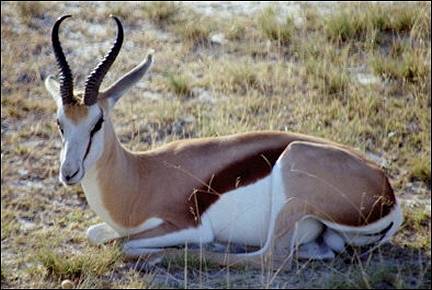
|
Along the edge of Waterberg to Grootfontein, where the impact of the Hoba meteorite was strong enough to create mountains. In Etosha NP game gathers at the watering places. Near Brandberg one can see old murals by Bushmen. Via the seals at Cape Cross to the dunes of Sossusvlei and Fish River Canyon.
Travelogue: Geja Rijsman
Photos: Geja and Michael Rijsman, Jos Drabbels, Sophia Stein
Early in the afternoon we arrive at Zelda's shelter, 20 kilometers past the border with Botswana. Some cheetahs, a leopard, a caracal and baboons are sheltered here.
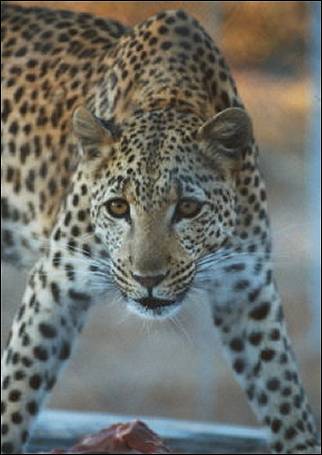
|
After lunch we visit the animals. There are baboons, goats and meerkats. The leopard doesn't show itself. We see two cheetahs by the edge of the cage. But when we get nearer, they disappear. We return to the leopard cage, because it will be fed at 4:30 PM.
We stay with the leopard for a long time and take lots of pictures. We tease it a little, by turning our backs on it, to which it responds every time with an attack. Apart from that, it looks very cute.
When we're almost back at the entrance, a jeep approaches and someone gestures at us. It turns out we're tresspassing, we can only visit the baboons. The leopard is still young (2.5 years) and might jump over the huge fence.
First the cheetahs are fed. There are seven of them, which explains the enormous cage. Pieces of meat are thrown over the fence. The largest animal wins every time, catches the meat and is off with its "prey." Which is fortunate for the weakest one, because the last piece happens also to be the biggest one.
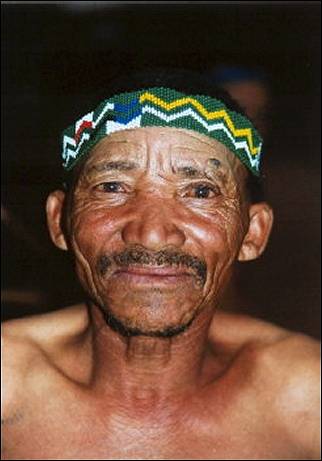
|
The meat for the leopard is in a separate part of its cage. When they open it, the leopard first marks its territory. Because it's alone, it's not in a hurry to eat.
The caracal has a much smaller cage with a roof. It hisses frightfully when someone gets too close. Fortunately the bars are very thick.
Then we visit the Bushmen. A couple of fat white guys has arranged this meeting and it's clear to us that they will pocket the lion's share of the revenue.
A kid throws a spear. That's really smart. Then we can watch them by their huts. It's a group of approximately 20 men and women, with only one child.
In their huts, we see their modern clothes, but at the moment they are wearing loincloths and little skirts, with some kind of tambourines around their ankles.
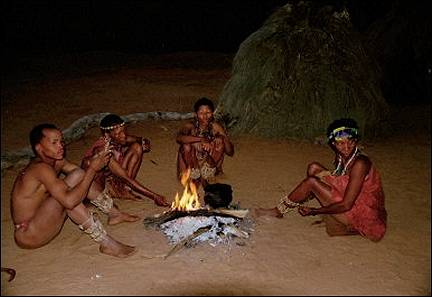
|
And then there is dancing. The singing is rather penetrating and gives me a headache. The child joins them, but clearly doesn't feel like it at all. Child labor!
We get meat and beer and something else. The meat is tasty, the rest is terrible. The child follows with a jar for tips. When they try to let everyone join them in a dance, we leave.
Waterberg and Grootfontein
The Hoba meteorite is the largest ever found
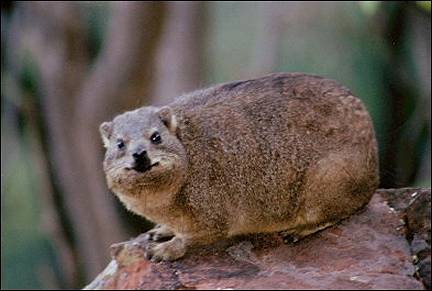
|
Early in the morning we leave in an SUV. We camp out in Gobabis. While everyone is still eating, we leave for the lookout. We need a little peace and quiet.
At first the path climbs gradually, until we have passed the swimming pool and the resort, then it gets steep. Beautiful red rocks hover above us. After 40 minutes we reach the top. On the way we pause for quite a while to admire, photograph and film some rock hyraxes.
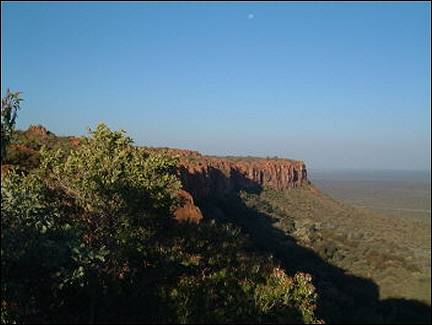
|
We are enjoying the view at the lookout when Jos and Sophia arrive. We decide to walk farther up the path. Eventually we arrive at a wonderful lookout, where we can see the earlier one far below us.
It's still very early when we leave next morning. We drive for over half an hour around the edge of Waterberg; the views are great. A little later we see two capricorns to the left of the road. Immediately after that, three giraffe necks pop up from the dense shrubs.
The gravel on the road and the surroundings change from red to white. We cross cattle grids regularly, or have to open a fence.
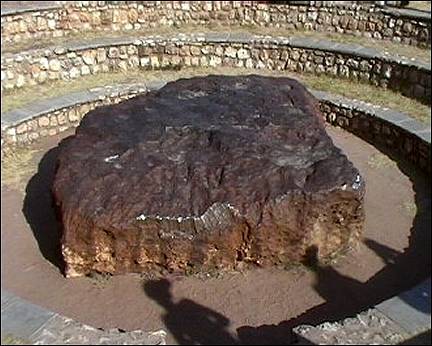
|
We arrive at the Hoba meteorite, near Grootfontein. This meteorite is the largest ever found on earth. One can see that the impact created mountains in its immediate surroundings. According to a brochure the meteorite storm covered a surface of 2500 square meters.
Etosha National Park
In the evening, the animals crowd the waterhole
We drive to Etosha. Here we see a giraffe herd on the side of the road. We stay there for a long while and enjoy the sight of these beautiful animals. There are three calves. A little after noon, we arrive at the Namutoni camping site at 1100 meters.
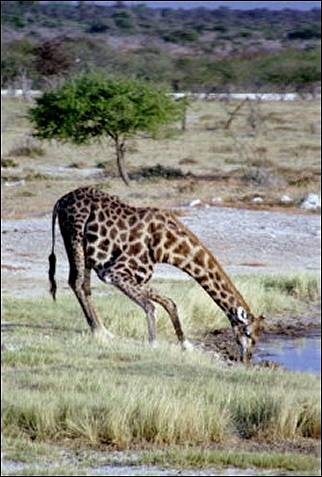
|
After lunch there's a game drive. We see an enormous amount of animals: giraffes and zebras, which we hardly saw before, except from the plane when we were over the Okavanga Delta and a few dead ones, so we're very happy.
We also see a huge elephant herd with many calves, a jackal, gemsbucks, and springbok. Also a few kudus, bat-eared foxes, wildebeast, austriches, warthogs and Kori buzzards.
After dinner we visit a dry watering place. Of course no animals here. The hole is dry because of a broken pump. When we're back, we take the hiking trail on the camping ground. We only see a giraffe standing close to the fence and it takes off when we get too close.
Next morning, we leave early for another game drive. Just outside the camp site we see a spotted hyena. Too bad it immediately bails. We see a lot of the same animals we saw yesterday. But no elephants.
But we do see a secretary bird, another spotted hyena and, best of all, a cheetah. At a great distance, but still wonderful. We stay for a long while, hoping it will get nearer. When the cheetah finally lies down in the grass, we drive to the watering place. There are no animals here and when we drive back, we see the cheetah again. We stop and wait.
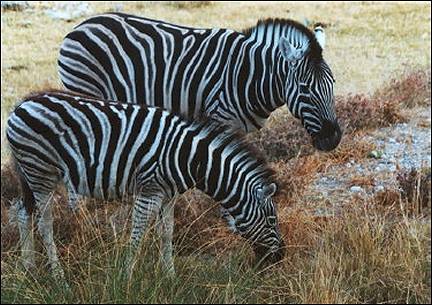
|
The cheetah spots a warthog coming from the bush and stalks it. But when we start the SUV, it gets scared and gives up the hunt. Too bad. Back on the camping site, we immediately leave for Halili, another camp site at the center of Etoshe National Park.
Our driver takes a detour along beautiful watering places, where we see lots of animals. Unfortunately no lions or leopards, but there are pretty giraffes, zebras, gemsbuck and sprinkbok. We also see capricorns in the shrubs a few times. Once we stop to take pictures. Too bad we don't stop when a dik-dik crosses the road just in front of the car, but we stop when we see a red hartebeest.
We lunch at Halali and have time to visit the waterin place there. Three kudu females just arrive to drink.
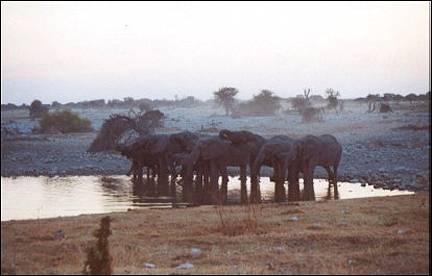
|
We drive to our next camping site, Okaukuejo. As soon as we can, we sit down near the watering place. When we arrive, there is a herd of 12 elephants, of which many are still young. When the elephants leave, they quarrel, trumpetting, with a group of jackals.
It takes a while until other animals show up. But there are many small birds, flying around the watering place. I get extremely annoyed with people who are talking way too loud. All of a sudden a lone elephant arrives to drink water. And then its' time for a large jackal clan.
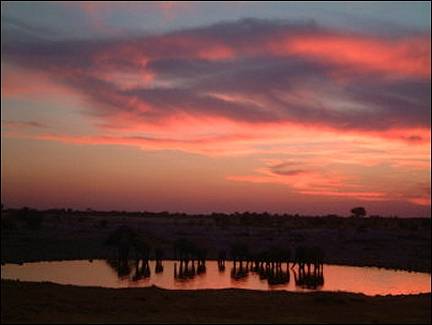
|
After dinner we return to the watering place. A huge elephant approaches. It walks to our side of the watering place and takes its time to drink. Then I think I spot a warthog on the edge of the circle of light.
But when it's near the watering place, it turns out to be a rhino. I expected those animals to be much bigger. Together with the elephant it drinks for a while. When both of them have left, more jackals arrive and twice a springbok.
Brandberg
At night the jackals wander around the tent
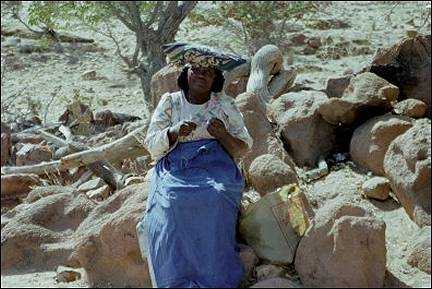
|
Next morning we pay a quick visit to the watering place, where we find a zebra herd. Then we have to leave. We ask our driver Janni to stop at the watering place, because Willemijn thought she saw a fox.
But it turns out to be a jackal. The zebras are still there, too, and a springbok herd arrives. We enjoy the view for 15 minutes and then leave the park.
Today we drive to Brandberg. The landscape is rather barren. The color of the earth changes back from white to red when we approach Brandberg. On the way, we stop in Outjo, where we can send e-mails home. We also stop when we see some women in traditional garb, who sell dolls in the same costumes.
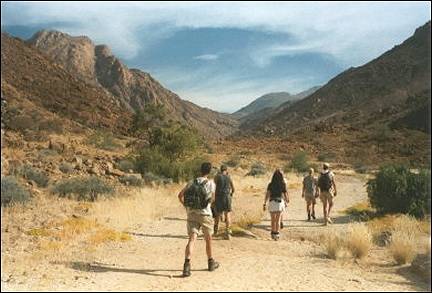
|
Early in the afternoon we arrive in Brandberg. We pitch our tents in a bush camp. Then we go hiking with a guide. We pass through a canyon between the hills and ascend only 110 meters. It's a nice, simple walk.
Our guide is a weird character, he misses his front teeth, smokes pot and speaks an incomprehensible English. Initially we try to understand, but little by little everyone gives up.
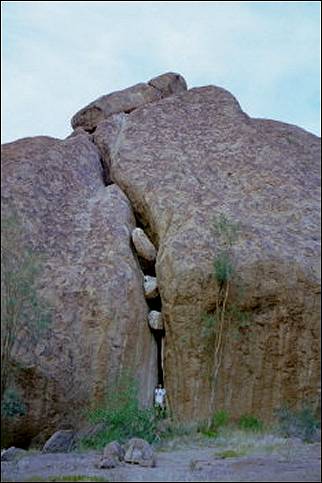
|
We admire the White Lady murals and other. They were made by real artists, the springbok, zebras and people are true to life. During our walk we only see hyraxes.
Back in the bush camp, Janni sticks a spade in the ground, to be used when we need to go to the bathroom. He has made a fire with coals he bought in Zambia and asks some of the men to gather kindling. Michael, Jos and Jay come back, sweating, with a huge tree trunk. With this, the fire will keep burning all night. The sun paints the clouds a beautiful red.
Then the meat is put on the fire. It's springbok in huge pieces. The meat is pre-cooked, so it's ready soon. We enjoy the rising of the full moon.
It's as if our tents sit on a snow field between the mountains, because of the white light. It's 10:30 when we turn in. During the night, jackals wander around the tent, but that doesn't keep me from visiting the bathroom.
Sesriem
The evening light paints the dunes red
We have to be careful when we roll up our tents next morning, because there could be a snake underneath the warm tent. Fortunately there isn't.
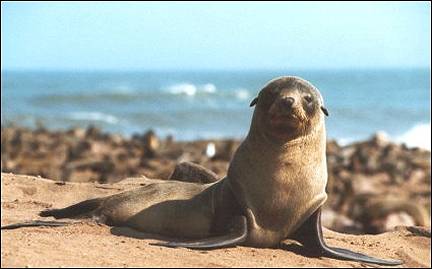
|
In a little over one and a half hours we drive to Cape Cross where we get half an hour to watch the seal colony. There are 130,000-180,000 seals here. The smell is overpowering, but it's fun and also impressive to be this close to so many seals.
We continue our drive to Swakopmund, a coastal town, where we arrive early in the afternoon. We spend the night in a hotel here.
Around 12:30 AM we are awoken by a yelling woman. She is very angry and probably looking for her adulterous husband to break a bone or two. She keeps yelling for at least a quarter of an hour.
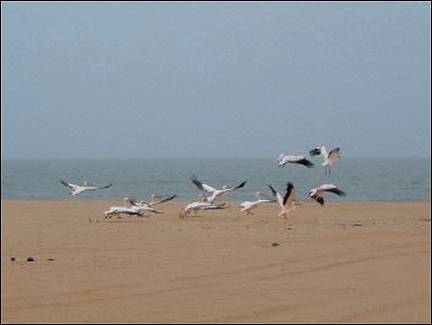
|
After breakfast we take a walk. First to the dunes, where we climb one hill. The sand is easier to walk on than we expected. On the way back to our hotel, we walk on the beach.
We stalk a group of pelicans. Near a lake by the sea are some flamingoes and on the rocks in the sea are cormorants.
The SUV picks us up at the hotel. Just outside Swakopmund we stop to climb a dune. Then we continue without a break to Walvis Bay. There we stop at the shore near a bay where there are many pelicans and flamingoes.
On the way we see beautiful rocks. We continue our trip to a camp site in Sesriem. Janni drives us to a nearby dune to see the sunset.
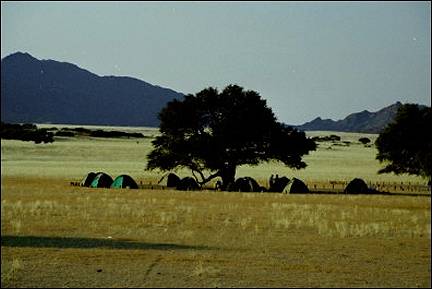
|
We climb the dune, but a disappointment awaits us. Behind it are higher dunes, behind which the sun will set. We keep climbing. When I climb one higher dune, there is another one, even higher.
I realize I'll never be up there in time and sit down despondently. The others, who just arrive, are discouraged as well. We decide to go down and see if we can get around the dune. We walk a great distance around the dune, but don't get far enough. But at a certain point we get close to two kudus which are a little higher up on grassland.
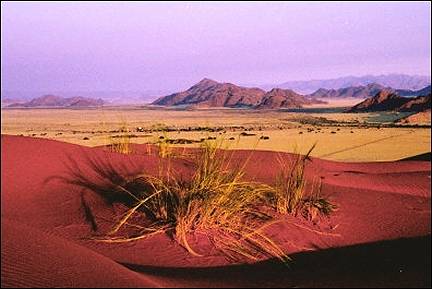
|
Michael arrives in time to take pictures. The light changes slowly with beautiful results. In the distance the grass seems green instead of yellow and the dunes get red.
We get up very early and drive in the icy cold to Dune 45 to watch the sunrise. A nice climb over the top of the dune brings us a great view. Slowly the dunes get red and redder when the sun comes up.
We are on time, fortunately, so this time we don't have to run up the dunes. We stay on the dune for a long time and enjoy the view and then we run, with Jos and Sophia back down on the steep side of the dune. Our feet sink in the sand, so we aren't fast at all.
We drive to Sossusvlei. There we take a walk. We follow the jeep tracks into the valley. On both sides high sand dunes rise up. Behind us, against the light, it seems as if the dunes are covered in a layer of snow, while at the same time, ahead of us, they have a beautiful red color.
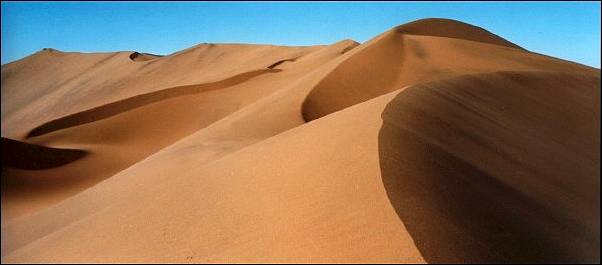
After an hour we decide to climb another dune and we arrive in the valley behind it. At first we think it's a mirage, but when we get nearer it turns out that there really is a lake here.
Jos has reached the top of a dune and Sophia is climbing toward him. As Bianca and Chris turn about, we try to cross the dunes walking back to the car. It's quite a climb.
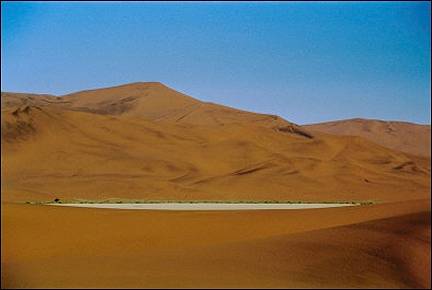
|
I'm afraid we won't be back in time. We have to climb higher and higher to cross dunes. Then we finally see a valley we can cross on level ground.
In the valley we even see a springbok, a gemsbuck and an austrich. >From this point, it's only one more kilometer across the dunes to the car. We still have to climb a lot, but these dunes are fortunately not that high. To my surprise we're back on time.
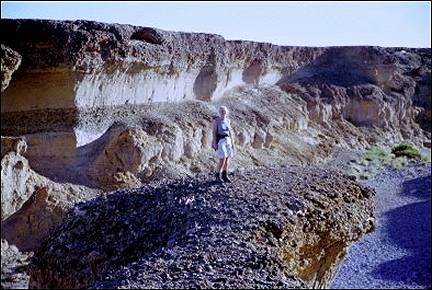
|
By the end of the afternoon Janni takes us to the Sesriem Canyon. According to legend, six reems of ox-leather were needed to get a bucket of water from the canyon, hence the name Sesriem (Six reem).
We descend into the canyon. After walking there for a while, we go back up and walk along the edge of the canyon back to the SUV.
Fish River Canyon
We walk along the edge to the next lookout
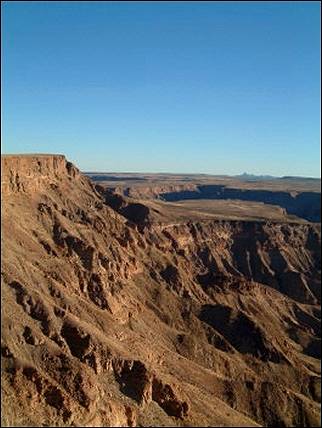
|
We leave early in the morning for the long drive to Fish River Canyon. The landscape changes from dunes to mountains and then we see the canyon. We stop for a moment to admire an aloe dichotoma (quiver tree).
We quickly pitch our tents and then leave for the canyon to see the sunset. Janni drops us at a lookout and we walk along the edge of the canyon to the next lookout. This is also the starting point for a hike of several days through the canyon. Unfortunately it's no longer allowed to hike in the canyon for only one day, because of accidents during those short hikes.
With the larger part of the group we watch the sunset, which doesn't quite paint the canyon as red as the brochure promised. Only when we're almost back at the car, the sky turns a gorgeous red. We turn in early. It's our last night in Namibia.
We leave at 7 AM for South Africa. There we visit Capetown and In Zuid-Afrika bezoeken we Kaapstad and the Table Mountain and then fly home.